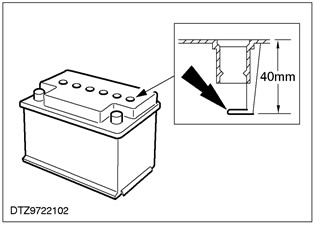WARNING: Keep batteries out of reach of children. Batteries contain sulfuric acid, so avoid getting battery acid on your skin, eyes or clothing. When working near the battery, wear protective goggles to protect against possible splashes of battery acid. If battery acid comes into contact with the skin or eyes, immediately flush the affected area with water for 15 minutes and seek immediate medical attention. If acid is swallowed, seek medical attention immediately. Failure to follow these instructions may result in personal injury.
WARNING: Batteries produce explosive gases that can cause injury, so keep fire, sparks, or flammable substances away from the battery. When charging the battery or working near the battery, always protect your face and eyes. Always provide adequate ventilation. Failure to follow these instructions may result in personal injury.
WARNING: Always follow all manufacturer's instructions when working with any charging equipment. Failure to follow this instruction may result in personal injury.
WARNING: Before turning on the charger, connect the charger to the battery. Failure to follow this instruction may result in personal injury.
WARNING: Turn off the charger before disconnecting the charger from the battery. Failure to follow this instruction may result in personal injury.
CAUTION: Batteries should not be charged in a vehicle.
CAUTION: Do not use a generator to recharge a dead battery, as this requires over eight hours of continuous operation without any additional load on the charging system.
NOTE: The maximum electrolyte level mark is approximately 40mm below the top of the battery.
Place the battery on a flat, level surface and check through the openings in the case to see if the electrolyte level reaches the indicated maximum mark.

WARNING: It is important not to overfill the battery as this can leak battery acid and cause corrosive damage to the vehicle. Failure to follow this instruction may result in personal injury.
2. If the level is below the maximum mark, remove the ventilation grilles and add battery acid to the cell (s) battery to the required level.
3. Cold batteries are unable to take charge immediately. Therefore, batteries should be allowed to warm up to approximately 5°C before charging (41°F). This may take four to eight hours at room temperature, depending on initial temperature and battery size.
4. A fully discharged battery may charge slowly at first, and in some cases may not accept a charge when the charger is set up normally. If the batteries are in this state, charging can be started in the position "Fully discharged battery" chargers that have this feature.
5. To determine if the battery is accepting a charge, follow the charger manufacturer's instructions for using the switch "Fully discharged battery". If a spring-loaded switch is installed, the switch must be held in the ON position for up to three minutes.
6. After releasing the switch "Fully discharged battery" and with the charger on, measure the battery voltage. If the meter reads 12V or higher, the battery is receiving charge and can be recharged. However, batteries whose temperature is less than 5°C (41°F), it may take up to two hours of charging before the charge rate is fast enough for the charge to be measured with an ammeter. It has been found that all undamaged batteries can be charged using this procedure. If the battery cannot be charged using this procedure, a new battery must be installed.
7. The quick charge procedure has been designed to recharge batteries that have passed the charge test and require only a recharge. This may be required in the event of battery operational problems resulting in an inability to start (The car engine does not turn over due to a weak battery), or due to the discharge of the battery in the car due to the load with the engine off.
8. With the wires disconnected, the battery can be quickly recharged using any of the following methods:
- Perform a 2-hour DC 20 A charge (manual charger setting).
- Perform a 2-Hour Constant Potential Charge (charger auto-configuration).
Visitor comments